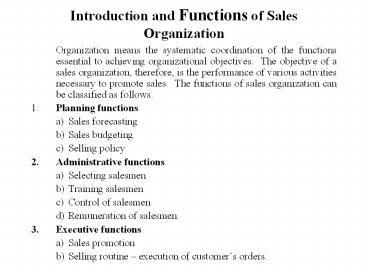Introduction%20and%20Functions%20of%20Sales%20Organization - PowerPoint PPT Presentation
Title:
Introduction%20and%20Functions%20of%20Sales%20Organization
Description:
Title: PowerPoint Presentation Last modified by: devender Created Date: 1/1/1601 12:00:00 AM Document presentation format: On-screen Show (4:3) Other titles – PowerPoint PPT presentation
Number of Views:108
Avg rating:3.0/5.0
Title: Introduction%20and%20Functions%20of%20Sales%20Organization
1
Introduction and Functions of Sales Organization
- Organization means the systematic coordination
of the functions essential to achieving
organizational objectives. The objective of a
sales organization, therefore, is the performance
of various activities necessary to promote sales.
The functions of sales organization can be
classified as follows. - 1. Planning functions
- a) Sales forecasting
- b) Sales budgeting
- c) Selling policy
- Administrative functions
- a) Selecting salesmen
- b) Training salesmen
- c) Control of salesmen
- d) Remuneration of salesmen
- Executive functions
- a) Sales promotion
- b) Selling routine execution of customers
orders.
2
Role of Sales Organization
- Once the sales plan has been formulated, the next
logical step is to organize a sales force to
achieve the organizational objective. The
qualified as sales objectives, which can be
further divided, are shown in figure 1 given
below. - Major Qualified Sales Objectives
- Break up or Division
- Quarter, month and weak
- Product line and range
- Region and sales area
- Type of customer
Overall objectives 1. Total volume of products
2. Total annual value of products 3. Total
annual selling costs 4. Total annual profit
contribution
Figure 1
3
Role of Sales Organization
- Sales organization has the following basic
purposes - Define the line of authority
- Ensure that all necessary activities are assigned
and performed - Establish lines of communication
- Provide for coordination and balance
- Provide insights into avenues of advancement
- Economics of executive time.
- Sales organization also depends on the type of
sales force which is used, for example, field
sales force, national account management, team
selling, telemarketing, part-time sales forces,
direct selling, etc.
4
Developing a Sales Organization
- Sales organization development refers to the
formal, coordinating process of communication,
authority and responsibility for sales groups and
individuals. An effectively designed sales
organization has a framework that enables the
organization to serve its customers. Once the
sales people know what their responsibilities are
and who they report to, they can concentrate on
doing their expected jobs to the best of their
ability. - Thus, a sales manager must recognize and deal
with some basic problems faced by organizations,
when developing his own sales organization. The
five major issues are - Formal and informal organizations
- Horizontal and vertical organizations
- The line and staff components of organizations
- The size of the company.
5
Formal and Informal Organizations
6
Formal and Informal Organizations
7
Horizontal and Vertical Organizations
Top Sales Executive
Regional or Zonal Sales Manager
District Sales Manager
Sales Supervisor
Salesperson
Figure 4 Vertical Sales Organization
8
Horizontal and Vertical Organizations
Top Sales Executive
Southern District Sales Manager
Southwest District Sales Manager
Foreign Sales Manager
New England District Sales Manager
Middle Atlantic District Sales Manager
Midwest District Sales Manager
Pacific District Sales Manager
Figure 5 Horizontal Sales Organization
9
Centralized and Decentralized Organization
- Line and Staff Components
- Marketing organizations also feature line and
staff components. - A line function is a primary activity and a staff
function is a supporting activity. - In a marketing organization, the selling function
is the line component whereas advertising,
marketing research, marketing planning, sales
training and distributor relations are usually
considered staff roles.
10
Centralized and Decentralized Organization
Vice President for Sales
General Sales Manager
Regional Sales Manager A
Regional Sales Manager B
Regional Sales Manager C
Figure 6 A Line Marketing Organization
11
Centralized and Decentralized Organization
12
Company Size and Organization
- A simple functional company organization is shown
in Figure 8 . This structure is appropriate for
most small and medium sized companies. These
companies have relatively few products or
services and use a limited number of distribution
channels. As each functional area grows larger,
the functional organization will be extended. A
functional marketing organization is shown in
Figure 9.
13
Company Size and Organization
President
Finance and Accounting
Production
Personnel
Sales and Marketing
Figure 8 Functional Company Organization
14
Company Size and Organization
Chief Marketing Executive
Advertising Manager
Customer Relations Manager
Market Research Manager
Sales Manager
Sales Supervisors
Salespeople
Figure 9 Functional Company Organization
15
Field Sales Organization
- Field sales force consists of salespersons who
work primarily with customers in person, although
they may also use the telephone or assistance
from computer links to expedite orders and
provide customer service. The structure of a
field sales force is usually based on some means
of specialization, such as geography, market,
product, or activity/function, or a hybrid of
these types. The following are the important
field sales - Geographic sales specialization organization
- Product-based sales specialization organization
- Customer-based specialization organization
- Hybrid sales organization
- Team-based organization
16
Geographic Sales Organization
FMCG Sales
CENTRAL DIVISION
WEST DIVISION
EAST DEVISION
- Area Sales Manager
- Mumbai
- Surat
- Area Sales Manager
- Delhi
- Jaipur
- Chandigarh
- Area Sales Manager
- Kolkata
- Patna
Figure 10 Geographical Sales Organization
Some advantages of geographic organizations are
(a) Proper coverage of territory (b) Defining the
responsibility (c) Familiarity with local
economic and competitive conditions, making them
better able to serve local customers.
17
Figure 11 Product-based Sales Organization
Medical Division of K Pharma Ltd.
Pharmaceuticals
Equipment
Supplies
18
Figure 12 Customer-based sales Organization
Sales Manager for India
Regional Manager
Branch Sales Manager
Assistant Sales Manager Health Care Products
Assistant Sales Manager- Agricultural Products
19
Activity/Function-based Organization
Activity
Sales Method
Telemarketing/cold calls
Prospecting
Presentation
Face-to-face field sales
Service
Personal visits
20
Figure 13 Hybrid Sales Organization
21
Team-based Sales Organization
Customer
Sales
Marketing
Technical Support
Manufacturing
Figure 14 Supplier Selling Team





























